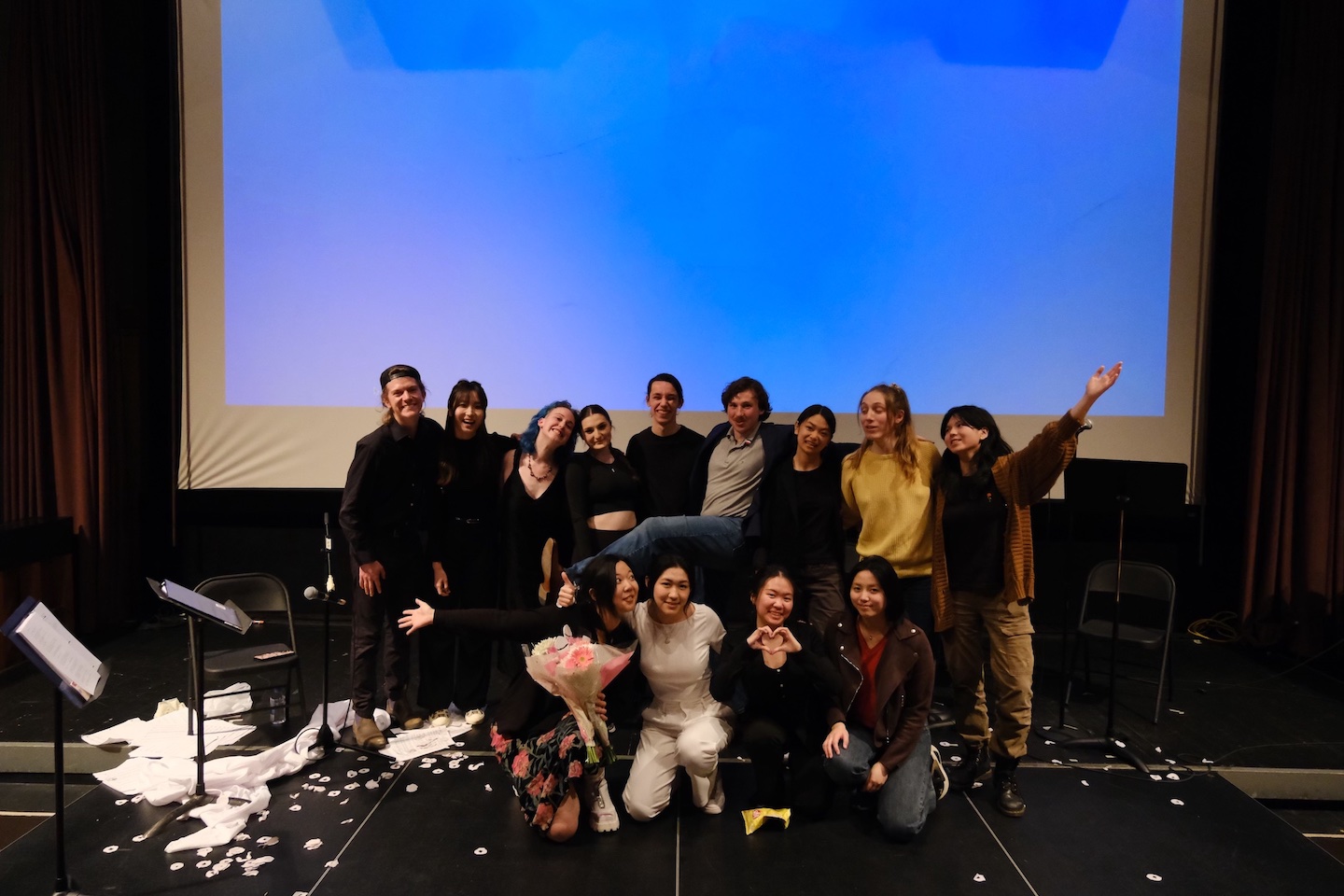
c/o Penny Zhang
As I hurried to the Ring Family Performing Arts Hall on Saturday, April 13 at 8:15 p.m. to take my seat for the musical “Find the Moon,” I felt excitement building within me. I had heard a little about “Find the Moon” from a friend, but I was uncertain of what to expect. “Find the Moon” combines elements of vulnerability and creativity, with just a little bit of spontaneity to highlight the truth of valuing your own work as an artist.
Written by Sonia Guan ’24 and directed by April Schwartz ’24, “Find the Moon” tells the story of Reed (Fiona Jin ’27), a writer on her deathbed trying to figure out what to do with the stories of her three characters, who are unhappy and want to end their lives: the artist (Stuart Conrad ’26), the worker (Hao Fu ’26), and the lover (Ting Tsai ’27). There is also a relationship between Reed and her reincarnation of herself (Bailee Gull ’24), as Reed tries to deal with her understanding and misunderstanding of her three characters and their feelings of misery. This show does an excellent job examining self-deprecation in the context of an artist’s relationship with her work and her characters, as well as offering an exquisite representation of learning to acknowledge feelings of confusion and vulnerability when you don’t want to live anymore.
I was fascinated that Guan chose to focus the emotional core of her work on confusion, allowing “Find the Moon” to better examine artists’ experience with pieces of their work that they might not like or fully finish.
“It’s just [centered around] confusion instead of vulnerability,” Guan said. “I’m always confused where my art can lead me to.”
Schwartz emphasized the importance of finding motivation and understanding behind those feelings of confusion.
“A lot of what we were doing there is like, ‘Okay, why do we want to do this?’” Schwartz said. “So that it’s not just the super vulnerable, like, ‘Ah, so sad,’ but so that it’s actually motivated with a reason.”
In a show so focused on personal and communal emotional turmoil, it was important to find community and joy in the rehearsal process with others. Schwartz talked about what this joy looked like for her.
“When we’re first introduced [to] the band, that’s always a lovely moment,” Schwartz said. “It always goes from feeling like, ‘Oh my God, this show is going nowhere,’ to suddenly, ‘Oh, we have an actual show.’”
Performed by such an incredible and versatile cast, “Find the Moon” also raises a question about the use of metaphor in musicals and its meaning for viewers. The characters are unable to find happiness and feel like they are enough as they are, yet there were varied possible interpretations of the plot. What does that mean for the audience? How do we connect our own feelings of insecurity and misunderstanding with those of the characters? What can we take away from a viewing of this show?
“Originally, when I started my first job, I wanted to create something,” Guan said. “The moon in Chinese culture is something far away…. It’s not the consensus that people always want to search and find, and there [is] a lot of literature looking into connecting our wish or hope…with the moon. And then originally, I want[ed] to create a show that define[d] different kinds of people. And then I went to creating a process of finding something that can be defined by anyone by different factors.”
“Find the Moon” does a tremendous job of normalizing feelings of uncertainty about death and making sure to acknowledge the reality that you might not always feel happy in one moment or in life. Each actor was able to convey the right amount of emotion, bringing each character to life as opposed to having others think on their behalf.
Schwartz also explained the origins of the characters in the show and how their beginnings add to each individual story.
“Because these characters start out in such a deep space, they don’t start out as fully-fledged characters,” Schwartz said. “But how to use a two-dimensional thing to create a three-dimensional performance. So how do you use [a] very boring [thing] to make that exciting, by playing up that two-dimensional character to such an extent that you can add in other parts, without making it look like you’re playing something else?”
If you didn’t manage to catch “Find the Moon,” you missed a beautiful show with a rich emotional core and truly realistic characters. Just as the cast and crew worked hard to bring this show to life, “Find the Moon” proved that bringing your own stories to life is never as impossible as it might seem.
Schwartz wanted to thank some of the people involved in this process.
“Shout out [Visiting Instructor of Theater] Tony Hernandez,” Schwartz said. “Tony Hernandez and [Assistant Professor of Theater] Courtney Gaston. Those two are so huge. The show wouldn’t have been perfect without them.”
Oluchi Chukwuemeka can be reached at ochukwuemeka@wesleyan.edu.